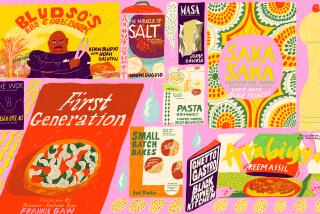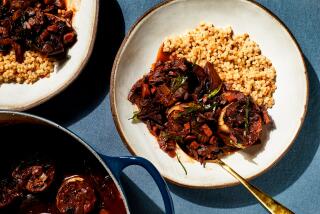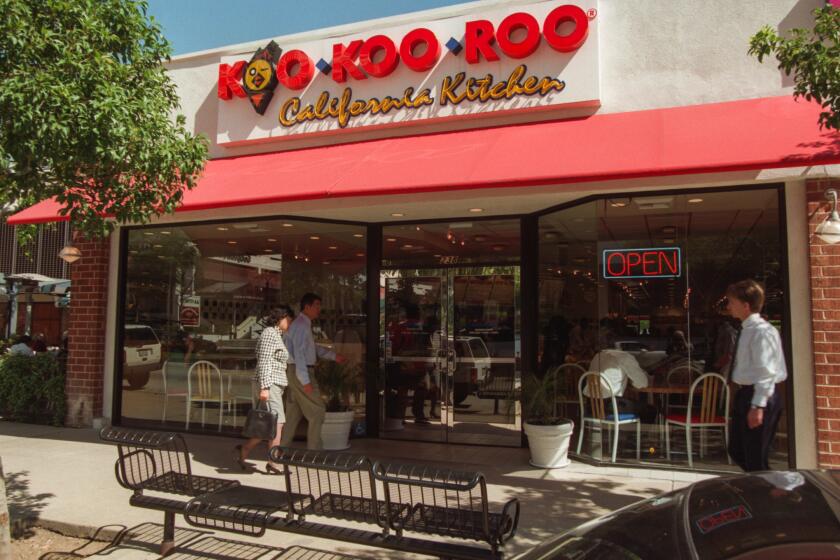Heaven from earth
FROM the kitchen, I heard the muffled whack of someone beating eggs and the softer thump of a knife chopping something on the cutting board. Sit down, my host urged, and he poured a glass of golden Chateauneuf-du-Pape blanc. It smelled, mysteriously, of white peaches and blossoms.
The beautiful, dark-haired cook set a huge flat omelet in front of us. Startlingly deep yellow, and studded with big chunks of black truffle, it had a powerful aroma of earth and funk. I took a bite and, it’s crazy, I know, began to hum.
Before that lunch at Francois and Annick Perrin’s Chateauneuf-du-Pape estate, Chateau de Beaucastel, I’d mostly encountered black truffles as tiny specks buried in a sauce, or as crisp, almost woody slices of something that had so little flavor, I had to take it on faith that this was, indeed, the fabled Tuber melanosporum, the prized fungus sniffed out by trained, truffle-hunting pigs in France, traditionally in the Southwest.
The ones I had in that omelet came from Richerenches in Provence, so they were, in effect, very local. In fact, these days, black truffles are much more abundant there than in Perigord. All the better, because the world’s appetite for truffles has only increased, and prices keep going up. And up.
Part of the lexicon of French haute cuisine, black truffles are expensive, but not as expensive as the white truffle from Italy’s Piedmont.
White truffles are more showy, giving away everything in their extravagant perfume. Maybe that’s why so many chefs feel compelled to amp up the flavor with a few drops of truffle oil. Not so the black truffle, which seems to reveal its secrets only when folded into eggs, or mayonnaise, or butter. It loves warmth and it loves fat. But precisely because it’s so expensive, chefs tend to use it in minute quantities in complicated dishes where its presence is difficult to detect except in menu descriptions.
Every year when black truffle season rolls around in late November, I long for Annick Perrin’s truffle omelet. Sometimes I get my fix at Chez Panisse in Berkeley, where chef Jean-Pierre Moulle serves soft scrambled eggs with truffles at the cafe. Tender as clouds and suffused with the taste of truffes noires, they come with rafts of grilled bread. With a bottle of Condrieu, it makes the most wonderful winter lunch.
I didn’t make it up there this year, so when I heard that the same supplier who provides truffles to Spago in Beverly Hills and other top restaurants in this country would also sell to the public, I got together some friends and ordered some from Plantin America Inc.
*
A family business
CHRISTOPHER Poron runs the business from the East Coast, while his father Herve takes care of the French side of things. With truffles, freshness is of the essence, so we wanted to plan our dinner party for the night or the night after we’d get the truffles. We found out that the shipments usually arrive in New York from France on a Monday and Poron can ship out by Fed Ex overnight the next day.
It’s been a difficult season this year, he said, with so much ground frozen, and so the quantity is less than usual. Still, he expects the season to last until mid-March, which gives us three more weeks to indulge. It’s very tempting, because the more you order, the lower the price (which includes shipping). For example, 2 ounces, which is basically two 1-ounce truffles, is $140. But if you order 6 or more ounces, the price can go as low as $50 an ounce, which makes getting together with friends to place an order a fine idea.
At the farmers market that Sunday, I bought some free-range eggs and the minute the truffles arrived, I put them in a jar with the eggs. That way the eggs take in some of the truffle aromas and flavor. When you make scrambled eggs with those truffle-infused eggs, the taste is explosive; intensified, of course, when you add in more truffle, julienned.
These truffles were beautiful, knobbly and coal black, a little smaller than golf balls, with all of their perfume intact. Every day that passes, though, they lose weight, flavor and aroma. Use them soon, or lose them.
I had no trouble at all with that. One truffle went into the scrambled eggs, which we served, a la Chez Panisse, with rafts of country white from La Brea Bakery, cut inch-thick and lightly toasted, then rubbed with garlic and drizzled with a little olive oil. Alongside the saffron-colored eggs we served a pretty little salad of frisee dressed in red wine vinegar and olive oil.
I took a bite of the eggs. I started to hum. And every subsequent bite elicited the same contented purring. In a restaurant, it would have cost four of us a fortune to indulge in anything laced with this amount of truffle. But we’d used just one of our truffles, which weighed in at a little more than an ounce. Divide the cost by four, and this sublime truffle hit seems almost reasonable.
Just for the record, though, when French three-star chef Paul Bocuse makes his scrambled eggs with truffle, he uses an astonishing 7 ounces of truffle for eight eggs, or just about one of the truffles we received for each egg! No butter for the maestro either, as he tells it in his 1992 cookbook, “Regional French Cooking” -- just a mere dollop of creme fraiche. And once he whisks the eggs with the truffles, he leaves the bowl to sit for an hour to further infuse the eggs with the taste of truffles before he cooks them.
In fact, it’s the simple dishes, like these eggs, that show truffles to their best advantage.
So what to do with a second truffle? Roast a chicken with some truffle slices tucked under the skin. We shaved six fine slices and slid them in under the breast. And as the chicken turned a dark gold in the oven, you could see the slices through the transparent skin, promising something delicious.
In fact, the truffles lose much of their taste in the cooking. Most of the flavor comes from truffle butter whisked into the juices just before serving.
Truffle butter? If I had just one truffle, I might be tempted to turn it all into truffle butter. Just mince up the truffle trimmings and fold them into softened unsalted to lightly salted butter, the best you can find. We used Double Devon Cream butter from Trader Joe’s. Roll it up into a log and wrap in plastic film. It can then be frozen without losing any of the flavor. The proportion is about one part truffles to two parts butter.
I used some a couple of days later to fold into a baked potato -- fantastic! You can toss fresh egg noodles or tagliarini in some of the truffle butter too. The simpler the better.
You can also use the minced truffle shavings to fold into a mayonnaise for celeri remoulade, an idea I got from one of Patricia Wells’ cookbooks. I had a little of the remoulade left over the next day and found the truffle flavor had deepened overnight, so this is something that benefits from being made ahead.
Vinaigrette, too, is a good use -- it seems to capture the truffle’s flavor in the oil. Make a vinaigrette with olive oil and wine vinegar that’s not too sharp, stir in a tablespoon of minced truffle and marinate halved, steamed fingerlings for a surprising potato salad. Sprinkle on more minced truffle, and chives, before serving.
*
Fancy-free
ANOTHER truffle went into a recipe from three-star chef Guy Savoy for lentils with black truffles. Somehow, I knew the taste of those tiny green lentils against the full-blown earthiness of the truffles had to be interesting, and it was.
It proved my point: You don’t have to be a skilled chef to do something wonderful with this ingredient.
Leave the foie gras and intricate sauces to the restaurant chefs. You’ll get a bigger hit if you invest in them yourself and show them off in simple dishes where the truffles and not a million other ingredients shine.
Rhone or Rhone-style wines seem to have a particular affinity for black truffles. Maybe it’s because both are earthy and lavishly perfumed. Somehow when a Syrah or a Roussanne or a Viognier crosses paths with that miraculous fungus, they make some kind of magic.
Eggs are notoriously difficult with wine. Add a truffle, and it seems to change the balance.
The fleshy richness of a Condrieu or Beaucastel’s glorious old vines Roussanne, or barring that rare bottle, their white Chateauneuf-du-Pape sidles right up to the egg and the truffle, playing the eggs’ bland goodness against the dusky earthiness of the truffle. Viognier, with its scent of violets, is another great match. Guigal Condrieu is a great example; even better is the producer’s stunning single vineyard Condrieu called La Doriane.
Roasted chicken with truffles wants a red, which could be a Hermitage from Chaves or a Chateauneuf from any of the great producers, such as Domaine du Pegau, but they’re not inexpensive. Domaine Grand Veneur, however, is a good, moderately priced Chateauneuf-duPape. A Gigondas or a Crozes-Hermitage would also do nicely.
For the lentil and truffle dish, I chose a Mourvedre from southern France, specifically Domaine Tempier’s Bandol rouge, for its bright fruit and darker tones. Domaine de Puech Chaud Coteaux du Languedoc, a Syrah from Cote Rotie producer Rene Rostaing, drinks equally well with this rustic yet sophisticated dish, and may be more of a bargain.
Now that I’ve done it, I’m thinking of making this an annual event. I’ll just have to decide which of my friends make next year’s truffle list.
*
(BEGIN TEXT OF INFOBOX)
A great source for fresh black truffles
THIS is the real thing: the firm that supplies truffles to top restaurants across the country, including Lee Hefter of Spago in Beverly Hills; Daniel Boulud of Daniel and Eric Ripert of Le Bernardin, both in New York; and Alain Ducasse. Plantin America Inc. is a father-son affair, with Herve Poron based in Southwest France and his son Christopher on the East Coast. Though Perigord in Southwest France is the most famous area in France for truffles, most are now found in the Southeast, near Richerenches in Provence; that’s the primary source of Plantin’s truffles. The season is relatively long, roughly from November to February or March. Plantin generally doesn’t start selling until December, when the truffles are a bit more mature. This year, with luck, the season is expected to go until mid-March, giving truffle fanciers three more weeks in which to indulge.
Though Plantin, which is based in New Jersey, has a website, it’s best to order fresh truffles by calling Christopher Poron directly. You’ll want to know when the next shipment is arriving and how early he can get the truffles to you in order to plan your truffle fest. And if you’re ordering more than just a few ounces, he’ll give you a better price. Right now, for example, two ounces are $140 (all prices include shipping), but order more and the price can drop from $70 an ounce to as low as $50. At the beginning of the season, truffles were more abundant and selling for $380 a pound: now they’re close to $700 to $800 a pound.
With truffles, the key is the fresher the better. With every day, they lose not only flavor, but also weight, so you want to buy (and use) them as fresh as possible. Plantin’s shipments usually arrive on Monday, and if there’s no problem with customs, he can ship out by next day Fed Ex -- Tuesday or Wednesday.
If you don’t get around to ordering truffles this season, not to worry -- you’ll have the information at hand to jump on it come next December.
Plantin, (201) 867-4590 or (212) 564-4313; fax (212) 658-9120; e-mail: info@plantin.com; website: www.plantin.com.
S. Irene Virbila
**
Scrambled eggs Panisse
Total time: 15 minutes
Servings: 4
Note: Adapted from “Chez Panisse Cafe Cookbook” by Alice Waters and the cooks of Chez Panisse. At Chez Panisse, fresh farm eggs are stored with black truffles in a closed container for two days before being used in this dish.
1 black truffle ( 1/2 to 1 ounce)
8 eggs
Salt and pepper
3 tablespoons butter, divided
1/4 pound salad greens, washed (use peppery little greens or frisee)
4 tablespoons olive oil, divided
1/2 teaspoon lemon juice
4 slices levain bread (country white from La Brea Bakery)
1 garlic clove, peeled
1. Brush the truffle with a damp cloth and scrape away rough spots and dirt with a paring knife. Slice the truffle into very thin rounds with a truffle shaver or Japanese mandolin; stack the rounds and cut crosswise into thin sticks.
2. Beat the eggs lightly with half the julienned truffles, one-half teaspoon salt and freshly ground pepper. Melt 1 1/2 tablespoons of the butter in an omelet pan over medium heat. Add the eggs, stirring with a wooden spoon to create soft curds. When the eggs lose their shine, cut the remaining butter into small pieces and stir in. Remove the pan from the flame when the eggs are still a bit too soft; they will continue to cook off the heat.
3. Divide the eggs among 4 warmed plates and garnish with the remaining slivered truffle. Quickly dress the salad greens with 2 tablespoons olive oil, lemon juice and salt, and put a handful of dressed greens alongside the eggs on each plate. Serve with toasted levain bread, drizzled or brushed with the remaining olive oil and rubbed with garlic.
Each serving: 345 calories; 9 grams protein; 16 grams carbohydrates; 1 gram fiber; 28 grams fat; 9 grams saturated fat; 207 mg. cholesterol; 223 mg. sodium.
**
Guy Savoy’s lentil ragout with black truffles
Total time: 1 hour
Servings: 6
Note: Adapted from “The Paris Cookbook” by Patricia Wells, who credits Restaurant Guy Savoy in Paris. Good-quality purchased chicken broth may be substituted for homemade.
1 1/2 cups French green lentils, preferably lentils du Puy
3 1/2 cups homemade chicken stock
1 carrot, peeled
1 small onion, peeled and stuck with a clove
1/2 teaspoon sea salt
1/4 teaspoon freshly ground black pepper
4 tablespoons unsalted butter, chilled, cut into small cubes
2 fresh black truffles (about 1 1/2 ounces total), cleaned; one-third minced, two-thirds cut into small triangles
1. Place the lentils in a large fine-mesh sieve and rinse under cold running water. Transfer them to a large (3-quart) heavy-duty saucepan, cover with cold water, and bring to a boil over high heat. When the water boils, remove the saucepan from the heat. Transfer the lentils to a fine-mesh sieve and drain over the sink. Rinse the lentils under cold running water. Return the lentils to the saucepan, add the chicken stock, and bring just to a boil over high heat.
2. Reduce the heat to a simmer. Using a slotted spoon, skim off any impurities that rise to the surface. Once the liquid is clear of impurities, add the carrot and onion. Simmer gently, uncovered, over low heat until the lentils are cooked yet still firm in the center, about 30 minutes. (The cooking time will vary according to the freshness of the lentils: The fresher they are, the more quickly they will cook.) Remove and discard the onion and carrot.
3. Transfer the lentils to a fine-mesh sieve set over a bowl. Drain, reserving the cooking liquid. Transfer 1 cup of the reserved liquid and 1 cup of lentils to the bowl of a food processor; puree.
4. Return the whole lentils and the puree to the saucepan. Add the sea salt and black pepper. Add the butter and the minced truffle and warm over low heat just until the flavors are blended. Taste for seasoning.
5. Transfer to small warmed plates, sprinkle with the truffle triangles, and serve immediately.
Each serving: 248 calories; 15 grams protein; 29 grams carbohydrates; 11 grams fiber; 9 grams fat; 5 grams saturated fat; 23 mg. cholesterol; 259 mg. sodium.
**
Truffle butter
Total time: 10 minutes
Servings: 6
Note: Use top-quality butter. We used Double Devon Cream butter.
3 tablespoons minced black truffles
6 tablespoons unsalted butter, softened
1. Peel the rough outside of the truffle with a peeler or paring knife before mincing, or use truffle scraps reserved from another recipe.
2. Mix the truffle into the softened butter. Form a log, wrap it in plastic and refrigerate.
Each tablespoon: 101 calories; 0 protein; 0 carbohydrates; 0 fiber; 11 grams fat; 7 grams saturated fat; 31 mg. cholesterol; 2 mg. sodium
**
Roast chicken with truffles and truffle butter
Total time: 1 hour, 10 minutes, plus overnight refrigeration
Servings: 4
1 Free-range chicken, 3 3/4 to 4 pounds
1 teaspoon kosher salt
1 (1- to 1 1/2 -ounce) truffle
1 cup chicken stock
2 tablespoons truffle butter
1. The night before, wash and thoroughly dry the chicken. Lightly salt the cavity and the outside of the chicken with kosher salt (kosher salt is essential). Loosely drape the chicken in paper towels, place in a pan or on a tray in the refrigerator and leave overnight.
2. Remove the chicken from the refrigerator 3 hours before you want to roast it. Rinse off the salt, dry the chicken and carefully place three thin slices of truffle (about one-sixth-inch thick) under the skin on each of the side of breast (six slices total), being careful not to rip the skin. Tie the chicken legs together with kitchen twine and let the chicken rest for 3 hours.
3. Heat the oven to 450 degrees. Heat a small heavy roasting pan (preferably not much larger than the chicken) at 450 degrees for 10 minutes.
4. Place the chicken in the hot roasting pan (no rack), breast side up. You’ll hear a sizzle and know it’s hot enough. A 4-pound chicken should take 55 minutes to 1 hour to roast. No basting is needed.
5. When the chicken is done, set aside on a cutting board, cover loosely with aluminum foil to keep it warm.
6. Meanwhile, pour off everything but a tablespoon or so of fat and set the roasting pan over a burner, scraping up the caramelized bits with a wooden spatula, and adding a splash or ladle of chicken stock, probably about a cup. Cook until it’s reduced and slightly thickened, remove from the heat, and whisk in 2 tablespoons of room temperature truffle butter.
7. Pour the juices into a sauce boat and add a tablespoon of minced truffle. Serve on the side with the chicken carved into pieces.
Each serving: 540 calories; 56 grams protein; 0 carbohydrates; 0 fiber; 33 grams fat; 11 grams saturated fat; 238 mg. cholesterol; 741 mg. sodium.
More to Read
Eat your way across L.A.
Get our weekly Tasting Notes newsletter for reviews, news and more.
You may occasionally receive promotional content from the Los Angeles Times.










